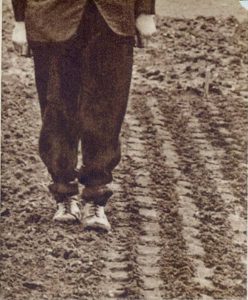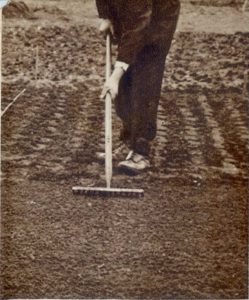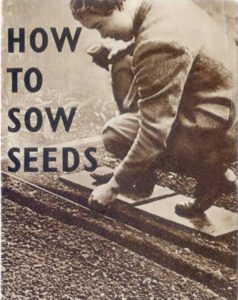 HOW TO SOW SEEDS
HOW TO SOW SEEDS
- Don’t try to sow seed when soil sticks to your boots. Wait for a fine spell.
- lf the ground is lumpy, first break up the lumps and level the surface with a rake.
- Before sowing, hoe or lightly fork the top 2 or 3 inches of soil, then carry on as shown in the following pictures.
- Not all seeds are sown at the same depth : 1 inch is best for beet, parsnips and spinach beet ; 3/4 inch for carrots, onions and turnips ; ½ inch for lettuces.
- Peas and beans are sown deeper : 2-3 inches for peas ; broad beans, 3 inches ; dwarf beans, 2 inches ; while for runner beans, first make a flat-bottomed trench 2 inches deep and 18 inches wide, and then sow the seed 3 inches deep in this. Don’t fill in the trench.
- lf possible, let your rows run north to south.
- Always sow thinly. Seed is precious.
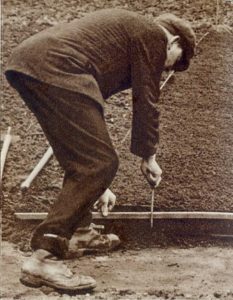
3 – Mark the position of the seed rows at both ends. You will need a measuring stick and a line. For distances between the rows, see Dig for Victory Leaflet No. 1
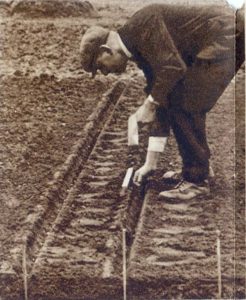
5 – Sow the seeds in a single even line in the drill a few seeds to the inch will be ample, except for peas, which should be 3 inches apart, dwarf and runner beans (9 inches) and broad beans (6 inches). Label the row.
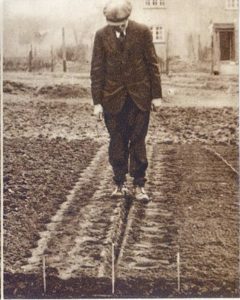
6 – Cover the seeds. A good way is to shuffle slowly along with a foot on either side of the drill, and without raising the feet slide the soil back and lightly press it. On heavy soil you may find it easier to scatter fine soil into the drill instead of trying to scuffle it in with your feet.
HOW TO USE A SEED BED
- For cabbage, sprouts, kales, sprouting broccoli and leeks, it is best to sow the seed in a separate part of the garden or allotment. In this way you can go on growing other crops in the part of the garden that is later to take the seedlings. Also, you save seed.
- Mark off a patch abour 6 feet by 4 feet for a 10-rod allotment or garden cropped according to the Ministry’s plan (Dig for Victory Leaflet No. I).
- Break down all lumps during a dry spell. Remove any stones and all roots of grass or weeds.
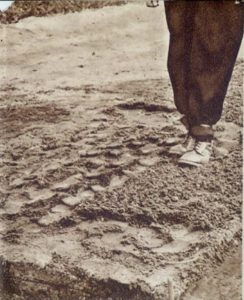
7 – Make the soil firm by treading it as soon as it is dry enough not to stick to your boots. Don’t stamp it down.
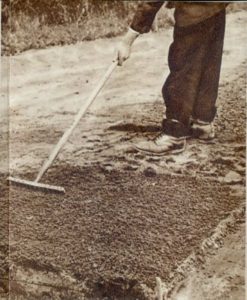
8 – Loosen the top surface by lightly raking it. Then place short sticks to mark the ends of the rows, which are 4 feet long across the patch and 6 inches apart. Stretch a line or string between the sticks.

Stand on a board so as not to tread the ground too hard, and make a shallow drill (about 1/2 inch deep) along the line with the point of a label or stick.
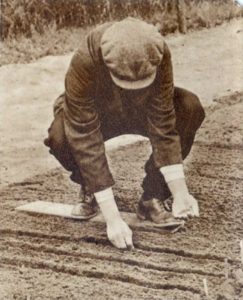
10 – Sow an even single line of seed along the bottom of the drill. Cover the seed as shown in picture 6 and rake over lightly. Label the row.
HOW TO PLAN YOUR GARDEN OR ALLOTMENT
Send for ‘ Dig for Victory’ Leaflet No. I (new series), Grow for Winter as well as Summer.
This free leaflet shows you by means of a simple coloured cropping chart how you can have vegetables all the year round if you—
DIG WELL AND CROP WISELY
Copies may be obtained from :
Ministry of Agriculture,
Hotel Lindum,
St. Annes-on-Sea,
Lancs.
Photographs reproduced from ” The Vegetable Garden Displayed” by permission of the Royal Horticultural Society
March 1942
